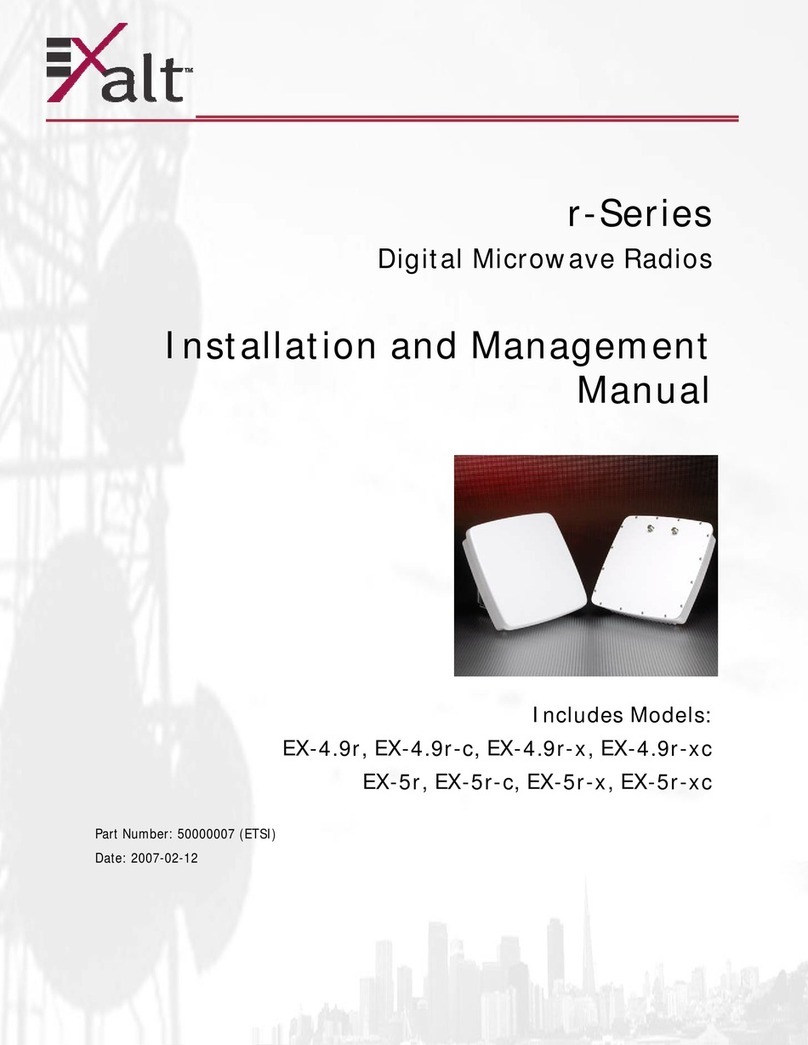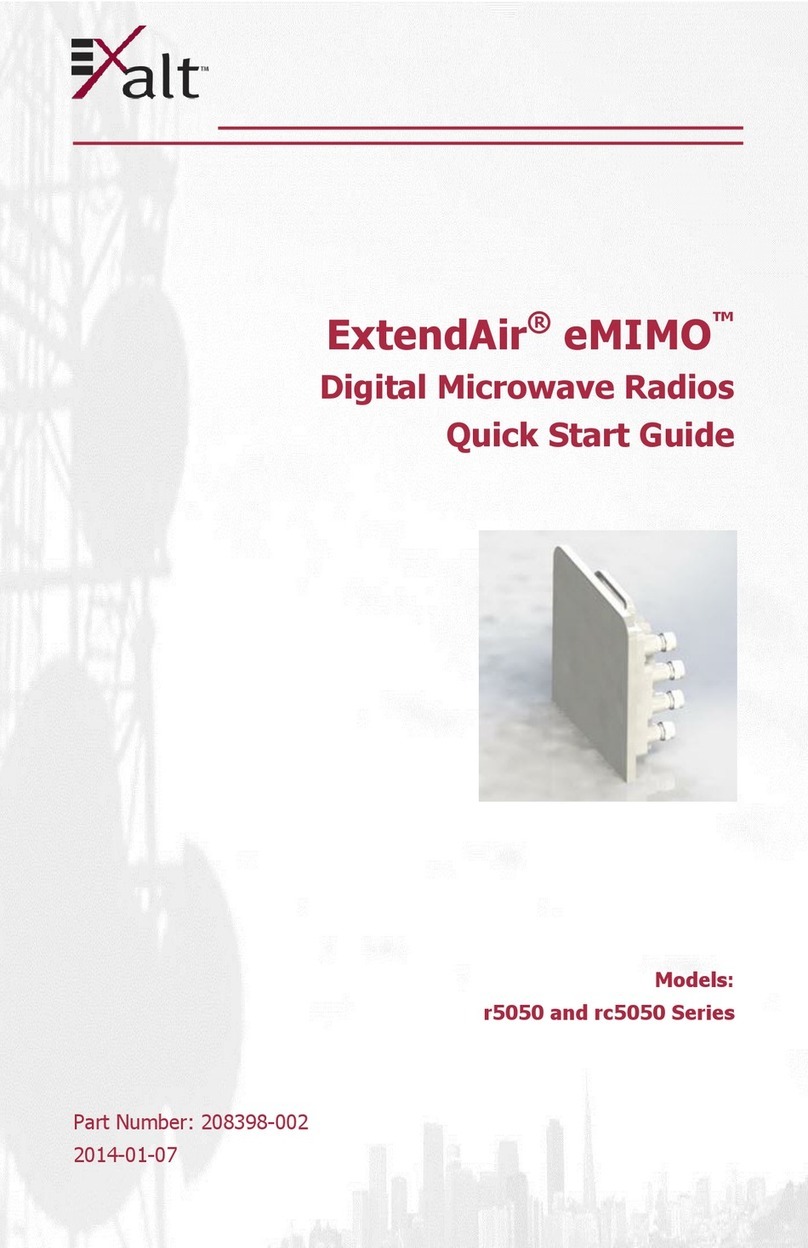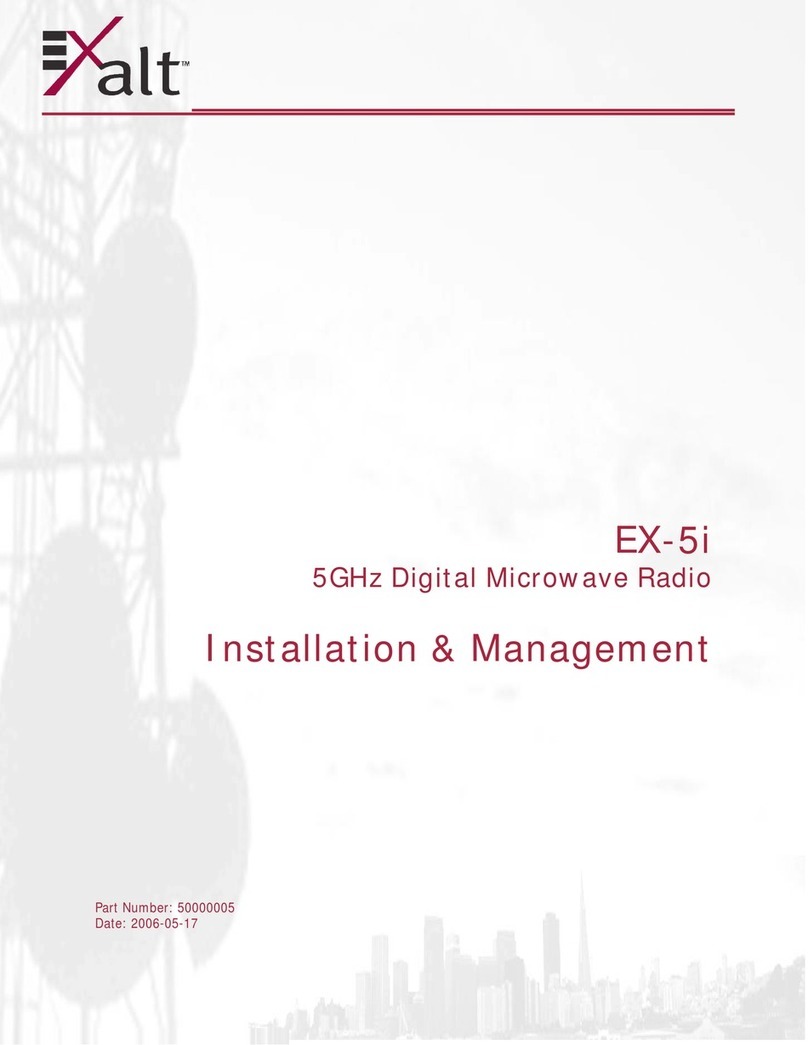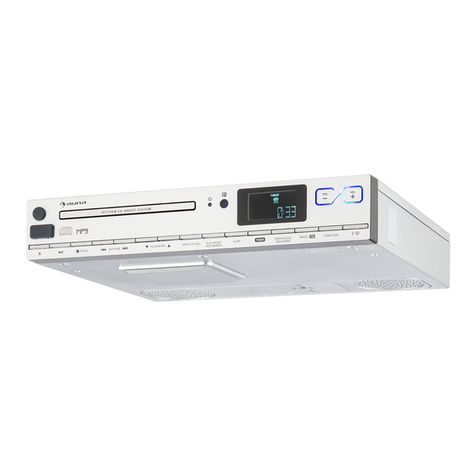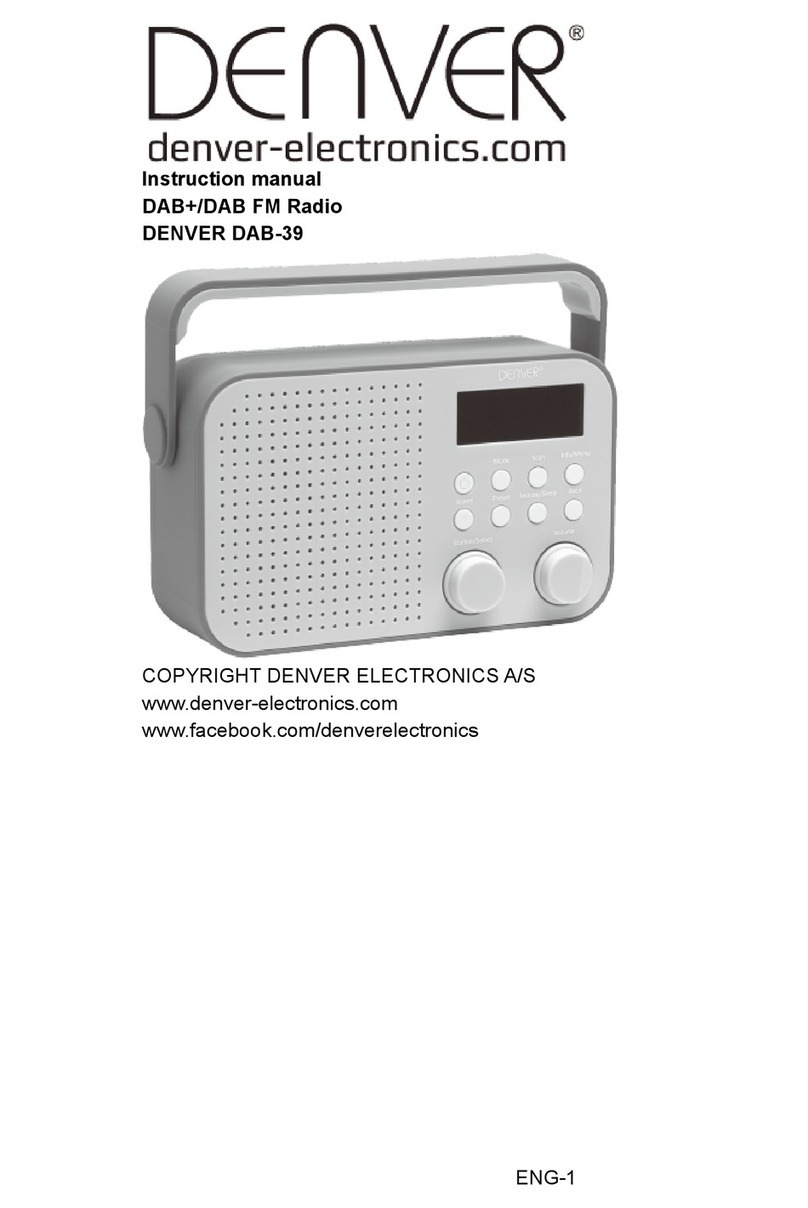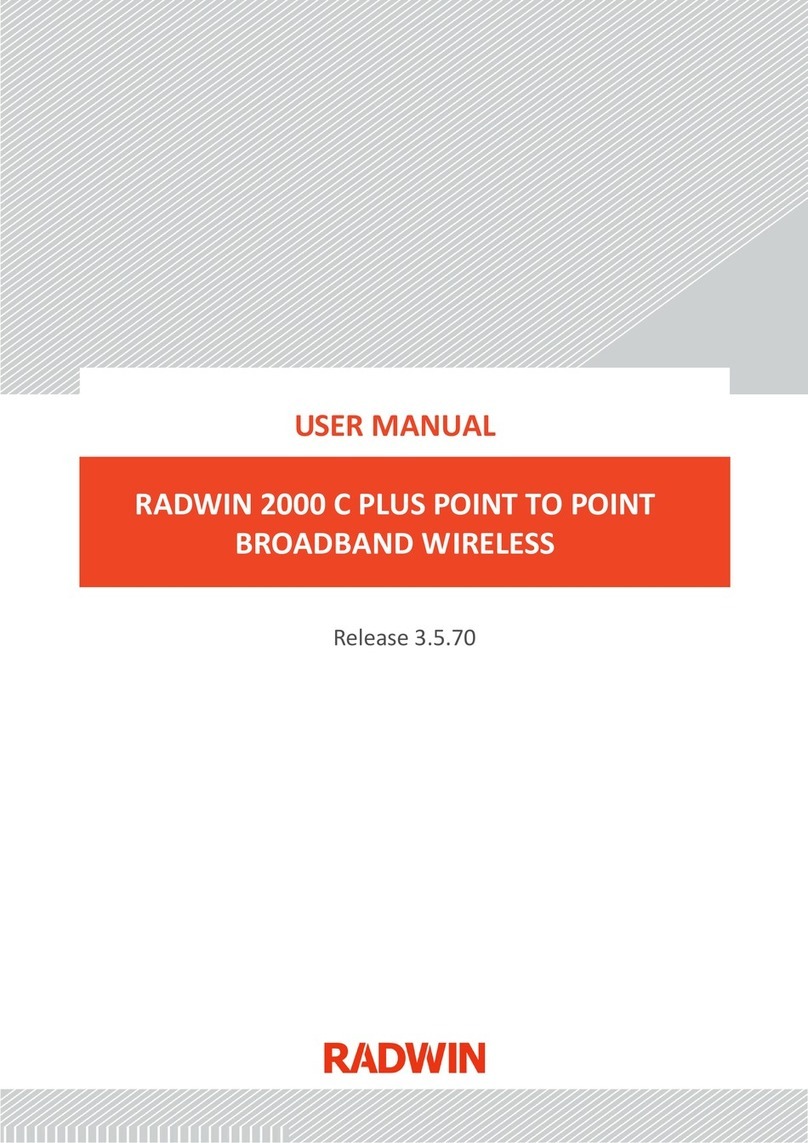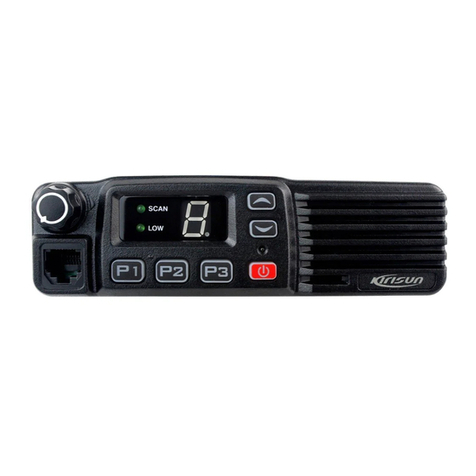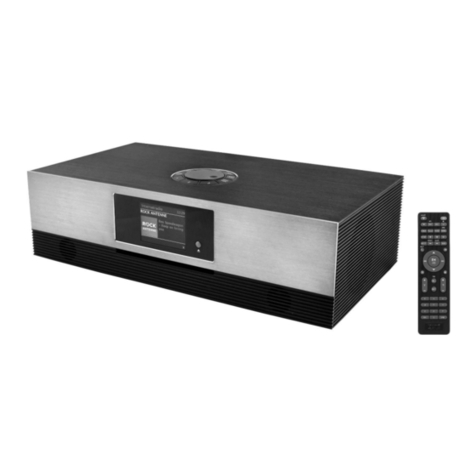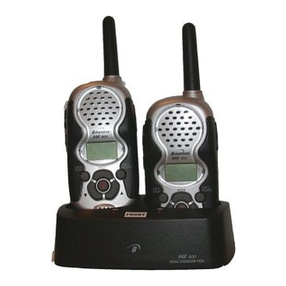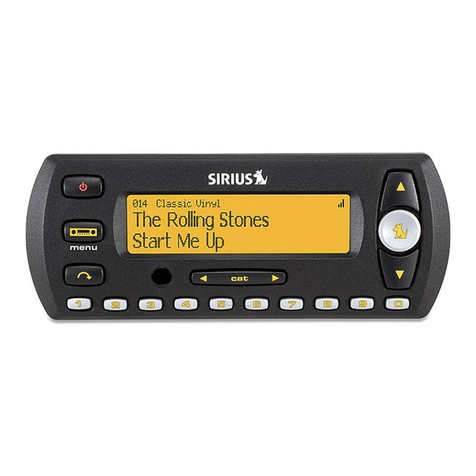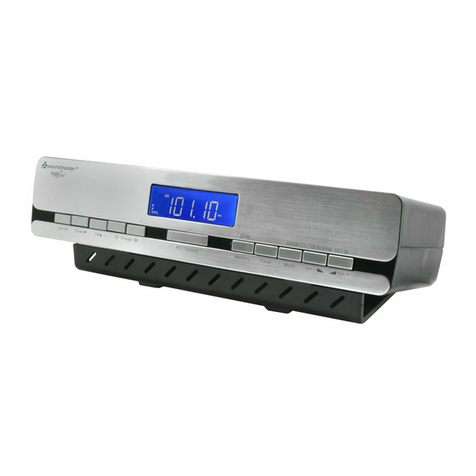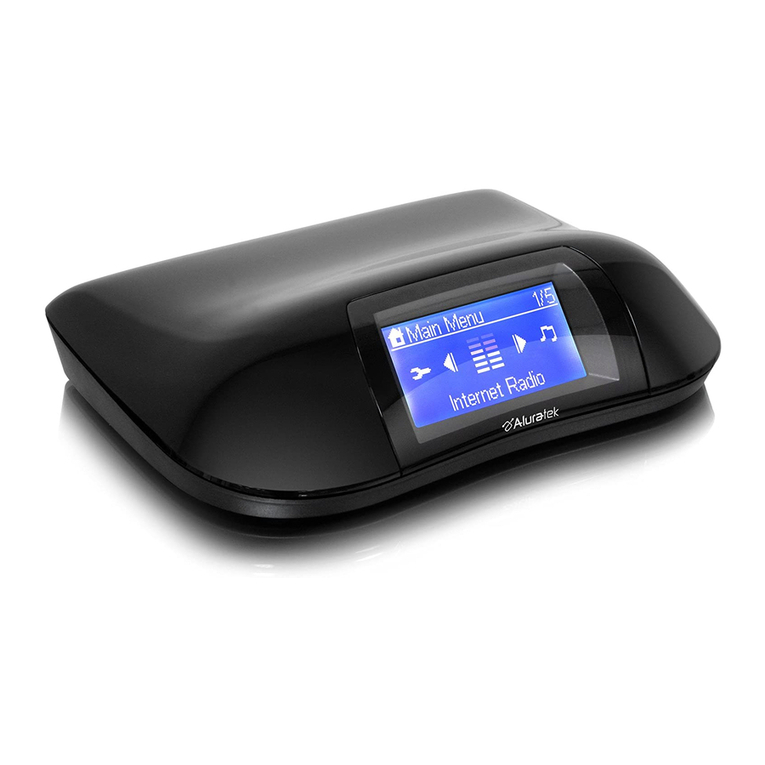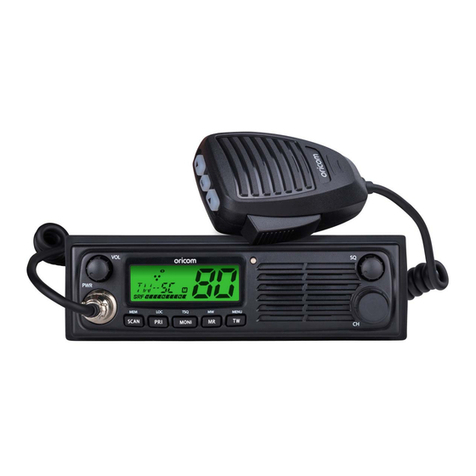Exalt ExtendAir r4900 Programming manual

203591-004
2010-09-20
ExtendAir (TDD) Series
Digital Microwave Radios
Installation and Management Guide
Models:
r4900 / rc4900
r4905 / rc4905
r4910 / rc4910
r5000 / rc5000
r5005 / rc5005
r5010 / rc5010
r5015 / rc5015

Exalt Installation and Management Guide
ExtendAir (TDD) Series
ii 203591-004
2010-09-20
Legal Notice
The information contained herein is the property of Exalt Communications, Inc. (“Exalt”) and is
supplied without liability for errors or omissions. No part of this document may be reproduced, in any
form, except as authorized by contract or other written permission from the owner.
Any brand names and product names included in this manual are trademarks, registered trademarks, or
trade names of their respective holders.
The contents of this document are current as of the date of publication. Exalt reserves the right to
change the contents without prior notice.
The publication of information in this document does not imply freedom from patent or other rights of
Exalt or others.
© 2010 Exalt Communications Inc. All rights reserved.
The Exalt logo is a trademark of Exalt Communications, Inc.
Open-Source License Information
Per the terms of your Exalt Limited Hardware Warranty, Software License, and RMA Procedures
Agreement with Exalt Communications, Inc. and/or its subsidiaries, certain Third Party Software may
be provided with and as part of the Exalt products provided to you, and any such Third Party Software
files provided are governed by the terms of their separate Third Party Licenses, which licenses give
you at least the license rights licensed to you in the Exalt End User Agreement and may give you
additional license rights as to the Third Party Software, but only with respect to the particular Third
Party Software to which the Third Party License applies.
The Exalt Products may include or be bundled with some or all of the following third party software.
Copies of the copyright notices and license agreements for any or all of these may be requested by
Open Source Code License Agreement Website
Embedded Linux - OS
U-Boot Boot Code. Both licensed under GPL Version 3 www.gnu.org
www.sourceforge.net
Busy Box Linux Commands. Licensed under GPL Version
2 www.gnu.org and
www.busybox.net
Scew Expat Wrapper. Licensed under LGPL Version 3 www.gnu.org
OpenSSL SSL Web Access. Licensed under dual license www.openssl.org
Net-SNMP SNMP Agent. Licensed under NetSNMP (see
Copyright Notices)
Dropbear SSH 2 Server; Expat - XML Parser; BarelyFitz –
Java Script Tabifier; and Flotr – Java Script
Plotting Library. All four are licensed under MIT
License
www.opensource.org/
licenses/mit-license.php
GoAhead Webserver Licensed under GoAhead License Agreement www.goahead.com

Exalt Installation and Management Guide
ExtendAir (TDD) Series
203591-004 iii
2010-09-20
Table of Contents
Legal Notice . . . . . . . . . . . . . . . . . . . . . . . . . . . . . . . . . . . . . . . . . . . . . . . . . . . . . . . . . . . . . . . ii
Open-Source License Information . . . . . . . . . . . . . . . . . . . . . . . . . . . . . . . . . . . . . . . . . . . . . . ii
List of Figures . . . . . . . . . . . . . . . . . . . . . . . . . . . . . . . . . . . . . . . . . . . . . . . . . . . . . . . . . . . . vii
List of Tables . . . . . . . . . . . . . . . . . . . . . . . . . . . . . . . . . . . . . . . . . . . . . . . . . . . . . . . . . . . . viii
Notes for Customers of the Cisco Configuration ExtendAir r5005 . . . . . . . . . . . . . . . . . . . . ix
About this Document . . . . . . . . . . . . . . . . . . . . . . . . . . . . . . . . . . . . . . . . . . . . . . . . . . . . . . . . x
Revision History . . . . . . . . . . . . . . . . . . . . . . . . . . . . . . . . . . . . . . . . . . . . . . . . . . . . . . . . x
Icons . . . . . . . . . . . . . . . . . . . . . . . . . . . . . . . . . . . . . . . . . . . . . . . . . . . . . . . . . . . . . . . . . . x
Introduction . . . . . . . . . . . . . . . . . . . . . . . . . . . . . . . . . . . . . . . . . . . . . . . . . . . . . . . . . . . . . . . 1
Related Documentation and Software . . . . . . . . . . . . . . . . . . . . . . . . . . . . . . . . . . . . . . . 1
The ExtendAir (TDD) Series Digital Microwave Radios . . . . . . . . . . . . . . . . . . . . . . . . 1
Basic Features . . . . . . . . . . . . . . . . . . . . . . . . . . . . . . . . . . . . . . . . . . . . . . . . . . . . . . . . . . 3
Pre-installation Tasks . . . . . . . . . . . . . . . . . . . . . . . . . . . . . . . . . . . . . . . . . . . . . . . . . . . . . . . . 6
Link Engineering and Site Planning . . . . . . . . . . . . . . . . . . . . . . . . . . . . . . . . . . . . . . . . . 6
Familiarization with the ExtendAir (TDD) Series Radios . . . . . . . . . . . . . . . . . . . . . . . . . 6
Shipping Box Contents. . . . . . . . . . . . . . . . . . . . . . . . . . . . . . . . . . . . . . . . . . . . . . . . . 7
Initial Configuration and Back-to-Back Bench Test . . . . . . . . . . . . . . . . . . . . . . . . . . . . . 8
RF Output Power Setting . . . . . . . . . . . . . . . . . . . . . . . . . . . . . . . . . . . . . . . . . . . . . . . 9
Time Division Duplex (TDD) Factors . . . . . . . . . . . . . . . . . . . . . . . . . . . . . . . . . . . . . . . . 9
Link Orientation and Synchronization . . . . . . . . . . . . . . . . . . . . . . . . . . . . . . . . . . . . . . . 10
Radio A/B Configuration . . . . . . . . . . . . . . . . . . . . . . . . . . . . . . . . . . . . . . . . . . . . . . 11
Radio Reset. . . . . . . . . . . . . . . . . . . . . . . . . . . . . . . . . . . . . . . . . . . . . . . . . . . . . . . . . 12
Radio Synchronization . . . . . . . . . . . . . . . . . . . . . . . . . . . . . . . . . . . . . . . . . . . . . . . . . . . 12
Synchronization Modes . . . . . . . . . . . . . . . . . . . . . . . . . . . . . . . . . . . . . . . . . . . . . . . 12
Offset Timing . . . . . . . . . . . . . . . . . . . . . . . . . . . . . . . . . . . . . . . . . . . . . . . . . . . . . . . . . . 15
When Sync is Lost . . . . . . . . . . . . . . . . . . . . . . . . . . . . . . . . . . . . . . . . . . . . . . . . . . . 16
Virtual Local Area Network (VLAN) . . . . . . . . . . . . . . . . . . . . . . . . . . . . . . . . . . . . . . . 16
Link Symmetry . . . . . . . . . . . . . . . . . . . . . . . . . . . . . . . . . . . . . . . . . . . . . . . . . . . . . . 16
Simple Network Management Protocol (SNMP) . . . . . . . . . . . . . . . . . . . . . . . . . . . . . . 17
System Installation and Initiation Process . . . . . . . . . . . . . . . . . . . . . . . . . . . . . . . . . . . . . . . 19
Record Keeping . . . . . . . . . . . . . . . . . . . . . . . . . . . . . . . . . . . . . . . . . . . . . . . . . . . . . . . . 20
Installation . . . . . . . . . . . . . . . . . . . . . . . . . . . . . . . . . . . . . . . . . . . . . . . . . . . . . . . . . . . . . . . 21
Mechanical Configuration and Mounting . . . . . . . . . . . . . . . . . . . . . . . . . . . . . . . . . . . . 21
Mounting the System . . . . . . . . . . . . . . . . . . . . . . . . . . . . . . . . . . . . . . . . . . . . . . . . . 21
Radio Ports and Indicators . . . . . . . . . . . . . . . . . . . . . . . . . . . . . . . . . . . . . . . . . . . . . . . . 22
Connector Overview. . . . . . . . . . . . . . . . . . . . . . . . . . . . . . . . . . . . . . . . . . . . . . . . . . 22
LED Indicators . . . . . . . . . . . . . . . . . . . . . . . . . . . . . . . . . . . . . . . . . . . . . . . . . . . . . . 23
Power . . . . . . . . . . . . . . . . . . . . . . . . . . . . . . . . . . . . . . . . . . . . . . . . . . . . . . . . . . . . . . . . 25
Terminating the RF Connectors (rc models) . . . . . . . . . . . . . . . . . . . . . . . . . . . . . . . 25
Optional AC Power. . . . . . . . . . . . . . . . . . . . . . . . . . . . . . . . . . . . . . . . . . . . . . . . . . . 26
Optional DC Power Injector . . . . . . . . . . . . . . . . . . . . . . . . . . . . . . . . . . . . . . . . . . . . 26
CAT5 Lightning/Surge Protection . . . . . . . . . . . . . . . . . . . . . . . . . . . . . . . . . . . . . . . . . . 27
Reset to Critical Factory Settings . . . . . . . . . . . . . . . . . . . . . . . . . . . . . . . . . . . . . . . . . . 28
Antenna/Transmission System . . . . . . . . . . . . . . . . . . . . . . . . . . . . . . . . . . . . . . . . . . . . 28
Initial Antenna Mounting (rc models) . . . . . . . . . . . . . . . . . . . . . . . . . . . . . . . . . . . . 28
Transmission Line from Antenna to Radio (rc models) . . . . . . . . . . . . . . . . . . . . . . . . . 29

Exalt Installation and Management Guide
ExtendAir (TDD) Series
iv 203591-004
2010-09-20
Indoor Mounting. . . . . . . . . . . . . . . . . . . . . . . . . . . . . . . . . . . . . . . . . . . . . . . . . . . . . 31
RF Lightning Arrestor . . . . . . . . . . . . . . . . . . . . . . . . . . . . . . . . . . . . . . . . . . . . . . . . 31
Antenna Alignment . . . . . . . . . . . . . . . . . . . . . . . . . . . . . . . . . . . . . . . . . . . . . . . . . . . . . 31
Configuration and Management . . . . . . . . . . . . . . . . . . . . . . . . . . . . . . . . . . . . . . . . . . . . . . 33
Telnet into the Command Line Interface (CLI) . . . . . . . . . . . . . . . . . . . . . . . . . . . . . . . . 33
Connect to the Radio in a Telnet Session . . . . . . . . . . . . . . . . . . . . . . . . . . . . . . . . . . 33
Telnet . . . . . . . . . . . . . . . . . . . . . . . . . . . . . . . . . . . . . . . . . . . . . . . . . . . . . . . . . . . . . . . . 33
Exalt Graphical User Interface (GUI) . . . . . . . . . . . . . . . . . . . . . . . . . . . . . . . . . . . . . . . 34
Preparing to Connect . . . . . . . . . . . . . . . . . . . . . . . . . . . . . . . . . . . . . . . . . . . . . . . . . 34
Make Connections . . . . . . . . . . . . . . . . . . . . . . . . . . . . . . . . . . . . . . . . . . . . . . . . . . . 34
Log In . . . . . . . . . . . . . . . . . . . . . . . . . . . . . . . . . . . . . . . . . . . . . . . . . . . . . . . . . . . . . 35
Login Privileges . . . . . . . . . . . . . . . . . . . . . . . . . . . . . . . . . . . . . . . . . . . . . . . . . . . . . 35
Quick Start . . . . . . . . . . . . . . . . . . . . . . . . . . . . . . . . . . . . . . . . . . . . . . . . . . . . . . . . . . . . 36
Navigating the GUI . . . . . . . . . . . . . . . . . . . . . . . . . . . . . . . . . . . . . . . . . . . . . . . . . . . . . 37
Summary Status Section. . . . . . . . . . . . . . . . . . . . . . . . . . . . . . . . . . . . . . . . . . . . . . . 37
Navigation Panel. . . . . . . . . . . . . . . . . . . . . . . . . . . . . . . . . . . . . . . . . . . . . . . . . . . . . 38
Radio Information Page . . . . . . . . . . . . . . . . . . . . . . . . . . . . . . . . . . . . . . . . . . . . . . . . . . 40
Administration Settings Page . . . . . . . . . . . . . . . . . . . . . . . . . . . . . . . . . . . . . . . . . . . . . . 41
Simple Network Management Protocol (SNMP) Configuration . . . . . . . . . . . . . . . . . . . 43
SNMP v1/v2c/v3 Support Options . . . . . . . . . . . . . . . . . . . . . . . . . . . . . . . . . . . . . . . 43
SNMP Traps . . . . . . . . . . . . . . . . . . . . . . . . . . . . . . . . . . . . . . . . . . . . . . . . . . . . . . . . 44
File Management Pages . . . . . . . . . . . . . . . . . . . . . . . . . . . . . . . . . . . . . . . . . . . . . . . . . . 46
File Transfer Page . . . . . . . . . . . . . . . . . . . . . . . . . . . . . . . . . . . . . . . . . . . . . . . . . . . . . . 46
File Activation Page . . . . . . . . . . . . . . . . . . . . . . . . . . . . . . . . . . . . . . . . . . . . . . . . . . . . . 49
System Configuration Page . . . . . . . . . . . . . . . . . . . . . . . . . . . . . . . . . . . . . . . . . . . . . . . 50
Ethernet Interface Configuration Page . . . . . . . . . . . . . . . . . . . . . . . . . . . . . . . . . . . . . . 55
T1/E1 Configuration Pages . . . . . . . . . . . . . . . . . . . . . . . . . . . . . . . . . . . . . . . . . . . . . . . 56
T1 Interface Configuration Page. . . . . . . . . . . . . . . . . . . . . . . . . . . . . . . . . . . . . . . . . 56
E1 Interface Configuration Page. . . . . . . . . . . . . . . . . . . . . . . . . . . . . . . . . . . . . . . . . 57
T1/E1 Loopback . . . . . . . . . . . . . . . . . . . . . . . . . . . . . . . . . . . . . . . . . . . . . . . . . . . . . 58
VLAN Configuration Page . . . . . . . . . . . . . . . . . . . . . . . . . . . . . . . . . . . . . . . . . . . . . . . 59
Ethernet Rate Limiting . . . . . . . . . . . . . . . . . . . . . . . . . . . . . . . . . . . . . . . . . . . . . . . . . . . 61
GPS Information Page . . . . . . . . . . . . . . . . . . . . . . . . . . . . . . . . . . . . . . . . . . . . . . . . . . . 62
Alarms Page . . . . . . . . . . . . . . . . . . . . . . . . . . . . . . . . . . . . . . . . . . . . . . . . . . . . . . . . . . . 63
Performance Page . . . . . . . . . . . . . . . . . . . . . . . . . . . . . . . . . . . . . . . . . . . . . . . . . . . . . . 65
Event Log Page . . . . . . . . . . . . . . . . . . . . . . . . . . . . . . . . . . . . . . . . . . . . . . . . . . . . . . . . 67
User Throughput Page . . . . . . . . . . . . . . . . . . . . . . . . . . . . . . . . . . . . . . . . . . . . . . . . . . . 68
Diagnostic Charts Page . . . . . . . . . . . . . . . . . . . . . . . . . . . . . . . . . . . . . . . . . . . . . . . . . . 70
Spectrum Analyzer Page . . . . . . . . . . . . . . . . . . . . . . . . . . . . . . . . . . . . . . . . . . . . . . . . . 72
Ethernet Utilization Page . . . . . . . . . . . . . . . . . . . . . . . . . . . . . . . . . . . . . . . . . . . . . . . . . 74
Reboot Page . . . . . . . . . . . . . . . . . . . . . . . . . . . . . . . . . . . . . . . . . . . . . . . . . . . . . . . . . . . 75
Manual Page . . . . . . . . . . . . . . . . . . . . . . . . . . . . . . . . . . . . . . . . . . . . . . . . . . . . . . . . . . 76
Specifications . . . . . . . . . . . . . . . . . . . . . . . . . . . . . . . . . . . . . . . . . . . . . . . . . . . . . . . . . . . . . 77
Physical Specifications . . . . . . . . . . . . . . . . . . . . . . . . . . . . . . . . . . . . . . . . . . . . . . . . . . 77
Integrated Antenna Models. . . . . . . . . . . . . . . . . . . . . . . . . . . . . . . . . . . . . . . . . . . . . 77
Connectorized Antenna Mode (rc models). . . . . . . . . . . . . . . . . . . . . . . . . . . . . . . . . 77
System Specifications, 4.9GHz Band . . . . . . . . . . . . . . . . . . . . . . . . . . . . . . . . . . . . . . . 79

Exalt Installation and Management Guide
ExtendAir (TDD) Series
203591-004 v
2010-09-20
System Specifications, 5.3GHz Band . . . . . . . . . . . . . . . . . . . . . . . . . . . . . . . . . . . . . . . 80
System Specifications, 5.4GHz Band . . . . . . . . . . . . . . . . . . . . . . . . . . . . . . . . . . . . . . . 81
System Specifications, 5.8GHz Band . . . . . . . . . . . . . . . . . . . . . . . . . . . . . . . . . . . . . . . 82
Interfaces . . . . . . . . . . . . . . . . . . . . . . . . . . . . . . . . . . . . . . . . . . . . . . . . . . . . . . . . . . . . . 83
Interface Connections . . . . . . . . . . . . . . . . . . . . . . . . . . . . . . . . . . . . . . . . . . . . . . . . . . . . . . 84
TDM Connections . . . . . . . . . . . . . . . . . . . . . . . . . . . . . . . . . . . . . . . . . . . . . . . . . . . . . . 84
RSL Sync Connector . . . . . . . . . . . . . . . . . . . . . . . . . . . . . . . . . . . . . . . . . . . . . . . . . . . . 84
Two Radio Internal Sync Out/In. . . . . . . . . . . . . . . . . . . . . . . . . . . . . . . . . . . . . . . . . 85
Sync Distribution Accessory . . . . . . . . . . . . . . . . . . . . . . . . . . . . . . . . . . . . . . . . . . . 85
Power/Ethernet Connector . . . . . . . . . . . . . . . . . . . . . . . . . . . . . . . . . . . . . . . . . . . . . . . . 85
Antennas . . . . . . . . . . . . . . . . . . . . . . . . . . . . . . . . . . . . . . . . . . . . . . . . . . . . . . . . . . . . . . . . 87
Troubleshooting . . . . . . . . . . . . . . . . . . . . . . . . . . . . . . . . . . . . . . . . . . . . . . . . . . . . . . . . . . . 89
General Practices . . . . . . . . . . . . . . . . . . . . . . . . . . . . . . . . . . . . . . . . . . . . . . . . . . . . . . . 89
Typical Indications of Issues . . . . . . . . . . . . . . . . . . . . . . . . . . . . . . . . . . . . . . . . . . . . . . 90
Improper RF Cable Termination . . . . . . . . . . . . . . . . . . . . . . . . . . . . . . . . . . . . . . . . . . . 91
Multipath Propagation . . . . . . . . . . . . . . . . . . . . . . . . . . . . . . . . . . . . . . . . . . . . . . . . . . . 91
RF Interference . . . . . . . . . . . . . . . . . . . . . . . . . . . . . . . . . . . . . . . . . . . . . . . . . . . . . . . . 91
Path Obstruction . . . . . . . . . . . . . . . . . . . . . . . . . . . . . . . . . . . . . . . . . . . . . . . . . . . . . . . 92
Misaligned Antenna . . . . . . . . . . . . . . . . . . . . . . . . . . . . . . . . . . . . . . . . . . . . . . . . . . . . . 92
Faulty Antenna ((connectorized antenna rc-models only) . . . . . . . . . . . . . . . . . . . . . . . . 92
Improper Grounding . . . . . . . . . . . . . . . . . . . . . . . . . . . . . . . . . . . . . . . . . . . . . . . . . . . . 92
Insufficient Link Margin . . . . . . . . . . . . . . . . . . . . . . . . . . . . . . . . . . . . . . . . . . . . . . . . . 93
Moisture in the Transmission System . . . . . . . . . . . . . . . . . . . . . . . . . . . . . . . . . . . . . . . 93
Back-to-back Bench Testing . . . . . . . . . . . . . . . . . . . . . . . . . . . . . . . . . . . . . . . . . . . . . . . . . 94
Basic Test . . . . . . . . . . . . . . . . . . . . . . . . . . . . . . . . . . . . . . . . . . . . . . . . . . . . . . . . . . . . . 94
Specification Performance Verification . . . . . . . . . . . . . . . . . . . . . . . . . . . . . . . . . . . . . . 95
General Compliance and Safety . . . . . . . . . . . . . . . . . . . . . . . . . . . . . . . . . . . . . . . . . . . . . . 96
Dynamic Frequency Selection . . . . . . . . . . . . . . . . . . . . . . . . . . . . . . . . . . . . . . . . . . . . . . . . 97
Safety Notices . . . . . . . . . . . . . . . . . . . . . . . . . . . . . . . . . . . . . . . . . . . . . . . . . . . . . . . . . . . . 98
Regulatory Notices . . . . . . . . . . . . . . . . . . . . . . . . . . . . . . . . . . . . . . . . . . . . . . . . . . . . . . . . 99
49xx Models . . . . . . . . . . . . . . . . . . . . . . . . . . . . . . . . . . . . . . . . . . . . . . . . . . . . . . . . . . 99
United States Compliance . . . . . . . . . . . . . . . . . . . . . . . . . . . . . . . . . . . . . . . . . . . . . . . . 99
Federal Communications Commission (FCC), United States . . . . . . . . . . . . . . . . . . 99
Canada Compliance . . . . . . . . . . . . . . . . . . . . . . . . . . . . . . . . . . . . . . . . . . . . . . . . . . . . 100
Industry Canada (IC), Canada . . . . . . . . . . . . . . . . . . . . . . . . . . . . . . . . . . . . . . . . . 100
Antennas Supported in Canada. . . . . . . . . . . . . . . . . . . . . . . . . . . . . . . . . . . . . . . . . 100
Europe and ITU Country Compliance . . . . . . . . . . . . . . . . . . . . . . . . . . . . . . . . . . . . . . 101
Regulatory Compliance . . . . . . . . . . . . . . . . . . . . . . . . . . . . . . . . . . . . . . . . . . . . . . . . . . . . 102
Regulatory Domain Keys . . . . . . . . . . . . . . . . . . . . . . . . . . . . . . . . . . . . . . . . . . . . . . . . . . . 104
EIRP Limits for the United States and Canada . . . . . . . . . . . . . . . . . . . . . . . . . . . . . . . . . . 106
EIRP for the USA and Canada . . . . . . . . . . . . . . . . . . . . . . . . . . . . . . . . . . . . . . . . . . . 106
4940–4990 MHz Band . . . . . . . . . . . . . . . . . . . . . . . . . . . . . . . . . . . . . . . . . . . . . . . 106
5250–5350 MHz Band . . . . . . . . . . . . . . . . . . . . . . . . . . . . . . . . . . . . . . . . . . . . . . . 106
5470–5725 MHz Band. . . . . . . . . . . . . . . . . . . . . . . . . . . . . . . . . . . . . . . . . . . . . . . 106
5725–5850 MHz Band. . . . . . . . . . . . . . . . . . . . . . . . . . . . . . . . . . . . . . . . . . . . . . . 107
EIRP Limits for Australia . . . . . . . . . . . . . . . . . . . . . . . . . . . . . . . . . . . . . . . . . . . . . . . . . . 108
5470–5725 MHz Band . . . . . . . . . . . . . . . . . . . . . . . . . . . . . . . . . . . . . . . . . . . . . . . 108

Exalt Installation and Management Guide
ExtendAir (TDD) Series
vi 203591-004
2010-09-20
5725–5850 MHz Band . . . . . . . . . . . . . . . . . . . . . . . . . . . . . . . . . . . . . . . . . . . . . . . 108
EIRP Limits for the European Union and ITU Countries . . . . . . . . . . . . . . . . . . . . . . . . . . 109
50xx Series EIRP . . . . . . . . . . . . . . . . . . . . . . . . . . . . . . . . . . . . . . . . . . . . . . . . . . . . . . 109
5250–5350 MHz band . . . . . . . . . . . . . . . . . . . . . . . . . . . . . . . . . . . . . . . . . . . . . . . 109
5470–5725 MHz band . . . . . . . . . . . . . . . . . . . . . . . . . . . . . . . . . . . . . . . . . . . . . . . 109
5725–5850 MHz band . . . . . . . . . . . . . . . . . . . . . . . . . . . . . . . . . . . . . . . . . . . . . . . 110
Declaration of Conformity to the R&TTE Directive
1999/5/EC . . . . . . . . . . . . . . . . . . . . . . . . . . . . . . . . . . . . . . . . . . . . . . . . . . . . . . . . . . . . . . 112
EU WEEE . . . . . . . . . . . . . . . . . . . . . . . . . . . . . . . . . . . . . . . . . . . . . . . . . . . . . . . . . . . 112
EU RoHS . . . . . . . . . . . . . . . . . . . . . . . . . . . . . . . . . . . . . . . . . . . . . . . . . . . . . . . . . . . . 113
Exalt Limited Hardware Warranty . . . . . . . . . . . . . . . . . . . . . . . . . . . . . . . . . . . . . . . . . . . . 114
Copyright Notices . . . . . . . . . . . . . . . . . . . . . . . . . . . . . . . . . . . . . . . . . . . . . . . . . . . . . . . . 119
Index . . . . . . . . . . . . . . . . . . . . . . . . . . . . . . . . . . . . . . . . . . . . . . . . . . . . . . . . . . . . . . . . . . 123

Exalt Installation and Management Guide
ExtendAir (TDD) Series
203591-004 vii
2010-09-20
List of Figures
Figure 1 Exalt ExtendAir (TDD) r5000 (integrated antenna model) . . . . . . . . . . . . . . . . . . 2
Figure 2 Mounting and cabling—integrated antenna model . . . . . . . . . . . . . . . . . . . . . . . . . 4
Figure 3 Cabling and mounting—external antenna model . . . . . . . . . . . . . . . . . . . . . . . . . . 4
Figure 4 Synchronized GPS sources . . . . . . . . . . . . . . . . . . . . . . . . . . . . . . . . . . . . . . . . . . 13
Figure 5 Internal Sync for two collocated radios . . . . . . . . . . . . . . . . . . . . . . . . . . . . . . . . . 14
Figure 6 Internal Sync for more than two collocated radios . . . . . . . . . . . . . . . . . . . . . . . . 14
Figure 7 GPS Sync for more than one collocated radios . . . . . . . . . . . . . . . . . . . . . . . . . . . 15
Figure 8 Synchronization for radios in a chain . . . . . . . . . . . . . . . . . . . . . . . . . . . . . . . . . . 15
Figure 9 Radio installation tasks . . . . . . . . . . . . . . . . . . . . . . . . . . . . . . . . . . . . . . . . . . . . . 19
Figure 10 Pole-mount example (integrated antenna version). . . . . . . . . . . . . . . . . . . . . . . . . 21
Figure 11 ExtendAir (TDD) Series connectors (model r5000) . . . . . . . . . . . . . . . . . . . . . . . 22
Figure 12 Power injector connectors . . . . . . . . . . . . . . . . . . . . . . . . . . . . . . . . . . . . . . . . . . . 27
Figure 13 CLI main menu . . . . . . . . . . . . . . . . . . . . . . . . . . . . . . . . . . . . . . . . . . . . . . . . . . . 33
Figure 14 Initiating the browser connection. . . . . . . . . . . . . . . . . . . . . . . . . . . . . . . . . . . . . . 35
Figure 15 Browser Login screen . . . . . . . . . . . . . . . . . . . . . . . . . . . . . . . . . . . . . . . . . . . . . . 35
Figure 16 Radio Information page . . . . . . . . . . . . . . . . . . . . . . . . . . . . . . . . . . . . . . . . . . . . . 36
Figure 17 Exalt GUI window description . . . . . . . . . . . . . . . . . . . . . . . . . . . . . . . . . . . . . . . 37
Figure 18 Summary status information . . . . . . . . . . . . . . . . . . . . . . . . . . . . . . . . . . . . . . . . . 38
Figure 19 Radio Information page . . . . . . . . . . . . . . . . . . . . . . . . . . . . . . . . . . . . . . . . . . . . . 40
Figure 20 Administration Settings page. . . . . . . . . . . . . . . . . . . . . . . . . . . . . . . . . . . . . . . . . 41
Figure 21 SNMP Configuration page. . . . . . . . . . . . . . . . . . . . . . . . . . . . . . . . . . . . . . . . . . . 43
Figure 22 Trap Configuration page . . . . . . . . . . . . . . . . . . . . . . . . . . . . . . . . . . . . . . . . . . . . 44
Figure 23 File Transfer page . . . . . . . . . . . . . . . . . . . . . . . . . . . . . . . . . . . . . . . . . . . . . . . . . 46
Figure 24 File Transfer page—download file link. . . . . . . . . . . . . . . . . . . . . . . . . . . . . . . . . 47
Figure 25 File Activation page. . . . . . . . . . . . . . . . . . . . . . . . . . . . . . . . . . . . . . . . . . . . . . . . 49
Figure 26 System Configuration page . . . . . . . . . . . . . . . . . . . . . . . . . . . . . . . . . . . . . . . . . . 50
Figure 27 Ethernet Interface Configuration page. . . . . . . . . . . . . . . . . . . . . . . . . . . . . . . . . . 55
Figure 28 T1 Interface Configuration page . . . . . . . . . . . . . . . . . . . . . . . . . . . . . . . . . . . . . . 57
Figure 29 E1 Interface Configuration page . . . . . . . . . . . . . . . . . . . . . . . . . . . . . . . . . . . . . . 57
Figure 30 External (remote) loopback . . . . . . . . . . . . . . . . . . . . . . . . . . . . . . . . . . . . . . . . . . 58
Figure 31 External (local) loopback. . . . . . . . . . . . . . . . . . . . . . . . . . . . . . . . . . . . . . . . . . . . 58
Figure 32 Internal loopback . . . . . . . . . . . . . . . . . . . . . . . . . . . . . . . . . . . . . . . . . . . . . . . . . . 58
Figure 33 VLAN Configuration page. . . . . . . . . . . . . . . . . . . . . . . . . . . . . . . . . . . . . . . . . . . 59
Figure 34 Ethernet Rate Limiting page . . . . . . . . . . . . . . . . . . . . . . . . . . . . . . . . . . . . . . . . . 61
Figure 35 GPS Information page . . . . . . . . . . . . . . . . . . . . . . . . . . . . . . . . . . . . . . . . . . . . . . 62
Figure 36 Alarms page . . . . . . . . . . . . . . . . . . . . . . . . . . . . . . . . . . . . . . . . . . . . . . . . . . . . . . 63
Figure 37 Performance page. . . . . . . . . . . . . . . . . . . . . . . . . . . . . . . . . . . . . . . . . . . . . . . . . . 65
Figure 38 Event Log page . . . . . . . . . . . . . . . . . . . . . . . . . . . . . . . . . . . . . . . . . . . . . . . . . . . 67
Figure 39 User Throughput page . . . . . . . . . . . . . . . . . . . . . . . . . . . . . . . . . . . . . . . . . . . . . . 68
Figure 40 Aggregate User Throughput Help page . . . . . . . . . . . . . . . . . . . . . . . . . . . . . . . . . 69
Figure 41 Diagnostic Charts page . . . . . . . . . . . . . . . . . . . . . . . . . . . . . . . . . . . . . . . . . . . . . 70
Figure 42 Spectrum Analyzer page . . . . . . . . . . . . . . . . . . . . . . . . . . . . . . . . . . . . . . . . . . . . 72
Figure 43 Spectrum analyzer graph example. . . . . . . . . . . . . . . . . . . . . . . . . . . . . . . . . . . . . 73
Figure 44 Ethernet Utilization page . . . . . . . . . . . . . . . . . . . . . . . . . . . . . . . . . . . . . . . . . . . . 74
Figure 45 Reboot page . . . . . . . . . . . . . . . . . . . . . . . . . . . . . . . . . . . . . . . . . . . . . . . . . . . . . . 75
Figure 46 Manual page. . . . . . . . . . . . . . . . . . . . . . . . . . . . . . . . . . . . . . . . . . . . . . . . . . . . . . 76

Exalt Installation and Management Guide
ExtendAir (TDD) Series
viii 203591-004
2010-09-20
Figure 47 TDM connectors . . . . . . . . . . . . . . . . . . . . . . . . . . . . . . . . . . . . . . . . . . . . . . . . . . 84
Figure 48 RSL & Sync In/Sync Out connector . . . . . . . . . . . . . . . . . . . . . . . . . . . . . . . . . . . 85
Figure 49 Power/Ethernet connector . . . . . . . . . . . . . . . . . . . . . . . . . . . . . . . . . . . . . . . . . . . 86
Figure 50 Basic back-to-back bench test configuration . . . . . . . . . . . . . . . . . . . . . . . . . . . . . 94
List of Tables
Table 1 Factory default settings . . . . . . . . . . . . . . . . . . . . . . . . . . . . . . . . . . . . . . . . . . . . . 11
Table 2 Connectors . . . . . . . . . . . . . . . . . . . . . . . . . . . . . . . . . . . . . . . . . . . . . . . . . . . . . . . 23
Table 3 LED indicators. . . . . . . . . . . . . . . . . . . . . . . . . . . . . . . . . . . . . . . . . . . . . . . . . . . . 24
Table 4 Recommended transmission line . . . . . . . . . . . . . . . . . . . . . . . . . . . . . . . . . . . . . . 30
Table 5 Default login information. . . . . . . . . . . . . . . . . . . . . . . . . . . . . . . . . . . . . . . . . . . . 35
Table 6 Alarm status indicators. . . . . . . . . . . . . . . . . . . . . . . . . . . . . . . . . . . . . . . . . . . . . . 64
Table 7 Supported antennas . . . . . . . . . . . . . . . . . . . . . . . . . . . . . . . . . . . . . . . . . . . . . . . . 87
Table 8 Product Approvals . . . . . . . . . . . . . . . . . . . . . . . . . . . . . . . . . . . . . . . . . . . . . . . . 102
Table 9 4.9GHz Regulatory Domain Keys . . . . . . . . . . . . . . . . . . . . . . . . . . . . . . . . . . . . 104
Table 10 5GHz Regulatory Domain Keys . . . . . . . . . . . . . . . . . . . . . . . . . . . . . . . . . . . . . 104
Table 11 EU and ITU Country Specific EIRP Levels . . . . . . . . . . . . . . . . . . . . . . . . . . . . 111

Exalt Installation and Management Guide
ExtendAir (TDD) Series Digital Microwave Radios
203591-004 ix
2010-09-20
Notes for Customers of the Cisco Configuration ExtendAir
r5005
Customers who purchased the Cisco configuration of the ExtendAir r5005 should note the following:
•The Cisco configuration ExtendAir r5005 has an integrated antenna. Sections of the manual that
refer to the rc5005 or any rc models (those with connectors for external antennas) are not relevant.
•The Cisco configuration ExtendAir r5005 is not available in the 5000, 5010, or 5015 variants nor
any 49xx variants. The specifications, connections, and capabilities listed for those models are not
applicable.
•The Cisco configuration ExtendAir r5005 does not employ the ‘Regulatory Domain Key’ (RDK)
feature. RDK is available regionally for specific regulatory compliance. All mention of the RDK is
not applicable. Cisco configuration radios provide specific the following capabilities for regional
regulatory domain compliance, as ordered:
– Certain frequency bands and/or tuning ranges are available and/or blocked from use
– EIRP (maximum output power) limits may be applied
– Channel bandwidth (size) selections may be limited and/or named in accordance with
regulations
– Dynamic Frequency Selection (DFS) may be enforced and not selectable, per regulations
•The Cisco configuration ExtendAir r5005 is provided standard with full Ethernet capacity and
128-bit AES encryption. No license keys are required for capacity, and only 256-bit AES
encryption is available as an upgrade license key.
•The Cisco configuration ExtendAir r5005 is packaged with the integrated AC power injector (not
sold separately). The DC power injector is not provided. Information regarding DC power is not
applicable.

Exalt Installation and Management Guide
ExtendAir (TDD) Series
x203591-004
2010-09-20
About this Document
This manual provides a complete description of the ExtendAir (TDD) Series Digital Microwave
Radios and related software. This manual provides planners, engineers, installers, system
administrators, and technicians general and specific information related to the planning, installation,
operation, management, and maintenance of these devices.
Revision History
Icons
The following icons denote specific types of information:
Date Products and Release code
2009-11-16 Models 5000, 5005, 5010, and 5015 initial release v1.0.0 through v1.1.3
2009-12-18 Models 4900, 4905 and 4910 initial release v1.0
2010-09-20 Update for Cisco-configuration r5005 release and Internal Sync release, v1.4.0
Note: This symbol means take note. Notes contain helpful suggestions or references to
materials not contained in the manual.
Warning! This warning symbol means there is a risk of electric shock. This situation that
could cause bodily injury. Before working on any equipment, be aware of the hazards
involved with electrical circuitry and be familiar with standard practices for preventing
accidents.
Caution! This symbol means be careful. There is a risk of doing something that might
result in equipment damage or loss of data. This is a general warning, caution, or risk of
danger.

Exalt Installation and Management Guide
ExtendAir (TDD) Series Digital Microwave Radios
203591-004 1
2010-09-20
Introduction
Exalt Communications, Inc. thanks you for your purchase. Our goal is to build the highest quality,
highest reliability digital microwave radio products. This commitment to quality and reliability
extends to our employees and partners alike. We appreciate any comments on how we can improve our
products, as well as your sales and Customer Care experience.
Related Documentation and Software
This manual makes reference to other documentation and software files that may be necessary. To
access all documents and software mentioned in this manual visit:
http://login.exaltcom.com/
You must have a user account to view all downloads. Follow the online instructions to create a user
account and request access.
The ExtendAir (TDD) Series Digital Microwave Radios
The Exalt ExtendAir (TDD) Series Digital Microwave Radios are the most advanced carrier-class
point-topoint terrestrial radio communications devices operating in the 4940 to 4990 or 5250 to 5875
MHz frequency bands. The ExtendAir (TDD) Series radios are available in the following
configurations:
•r-models have an integrated antenna.
•rc-models have a connector for external antenna connection
The ExtendAir (TDD) Series radios connect voice and/or digital data from one location to another,
obviating the need for copper or fiber connectivity, or enhancing existing connectivity by providing a
redundancy solution, a primary solution, and/or additional capacity. Figure 1 shows the ExtendAir
(TDD) Series r5000 digital microwave radio.
Customer Care Hotline (USA): (408) 871-9890
Toll-Free Customer Care Hotline (USA): (877) EXALT-01 (392-5801)
Direct-Dial Telephone (USA): (408) 871-1804
Website: www.exaltcom.com
Sales e-mail: sales@exaltcom.com
Mailing Address: Exalt Communications, Inc.
580 Division St.
Campbell, CA 95008
USA

Exalt Installation and Management Guide
ExtendAir (TDD) Series Digital Microwave Radios
2203591-004
2010-09-20
Figure 1 Exalt ExtendAir (TDD) r5000 (integrated antenna model)
The following ExtendAir (TTD) models are covered in this manual:
•r4900 and rc4900
– configured with 27Mbps aggregate Ethernet capacity (single PoE port)
– with license key upgrades for 55, 80, and 162Mbps aggregate capacity
•r4905 and rc4905
– configured with 27Mbps aggregate Ethernet capacity (1 PoE port plus 2 additional Ethernet
ports)
– with license key upgrades for 55, 80, and 162Mbps aggregate capacity
•r4910 and rc4910
– configured with 27Mbps aggregate capacity and 4xT1/E1 (single PoE port)
– with license key upgrades for 55, 80, and 162Mbps aggregate capacity
•r5000 and rc5000
– configured with 27Mbps aggregate Ethernet capacity (single PoE port)
– with license key upgrades for 55 and 162Mbps aggregate capacity
•r5005 and rc5005
– configured with 27Mbps aggregate Ethernet capacity (1 PoE port + 2 additional Ethernet
ports)
– with license key upgrades for 55 and 162Mbps aggregate capacity
•r5010 and rc5010
– configured with 27Mbps aggregate capacity and 4xT1/E1 (single PoE port)
– with license key upgrades for 55 and 162Mbps aggregate capacity
•r5015 and rc5015
– configured with 2Mbps aggregate Ethernet capacity and 2xT1/E1 (single PoE port)
– with license key upgrades for 27, 55, and 162Mbps aggregate capacity with license key
upgrade for 4xT1/E1
The ExtendAir (TDD) Series radios require a clear line-of-sight and proper path clearance to achieve a
high-performance, reliable connection. Perform professional path engineering and site planning before
installing this equipment.
The primary focus of this document is the installation and maintenance of the digital microwave radio,
and assumes that path engineering and site planning has already been performed.
The 50xx family ExtendAir (TDD) Series radios utilize radio frequencies in the 5250 to 5875 MHz
range. In most countries these frequency bands are considered as ‘license-exempt’ or ‘unlicensed.’
This means that virtually any user may use these frequencies freely, without paying for access, or any
type of prenotification, post-notification or registration. As a result of this designation, users may also
move or change these systems at any time, with significant flexibility to the location, orientation and
Note: The Cisco configuration r5005 is pre-configured to allow full capacity (162Mbps
aggregate) and 128-bit AES wireless encryption.

Exalt Installation and Management Guide
ExtendAir (TDD) Series Digital Microwave Radios
203591-004 3
2010-09-20
configuration of the system. However, due also to this designation, there may be uncontrolled
interference from other similar devices that occupy this spectrum. In these cases, it is up to engineering
and maintenance personnel to design the system with existing and future interference sources in mind,
recognizing that there is a chance that the interference conditions could be very dynamic, and outages
may occur on the system as a result, and that, in some very rare cases, the system may cause
interference into another system and may be required to be disengaged or modified/re-oriented to
eliminate the interference.
If the spectrum in your country is designated as ‘license-exempt’ or similar, this does not infer that the
installer may configure the system in any manner at any location. In most cases, there are regulations,
or device-based conditions that limit the use of the device, such as maximum gain antenna, antenna
types and maximum output power, as well as, in some cases, application limits, limited geography of
use, and other unique regulations. The link design engineer and/or professional installer must
determine these limitations and engineer/install the system within the confines of all local regulations.
Also, it is required to examine any regulations that may apply to peripheral equipment, installation and
cabling of the system that may be regulated for human safety, electrical code, air-traffic control, and
other safety-related categories.
In certain countries, the spectrum for this product is NOT considered to be license-exempt. In these
cases, there may be additional regulatory requirements concerning the location, frequency, power,
orientation, configuration, and other aspects of the system, including, in some cases, a need for link
registration, coordination, and fees that may apply to the system usage. Please consult your local
regulatory organization(s) to determine usage requirements.
The 49xx family ExtendAir (TDD) Series radios utilize frequencies in the 4940–4990MHz range,
which is typically a licensed band reserved for use by Public Safety agencies and applications.
In almost all cases, either for license-exempt or other designation, the product itself must be authorized
for use in your country. Either Exalt or Exalt’s agent must have applied for certification or
authorization to allow the sale and deployment of the system within the country. It is also possible that
only certain versions or configurations of the device are allowed within a particular country. Please
contact Exalt or your authorized Exalt representative for information pertaining to your country.
Basic Features
The ExtendAir (TDD) Series Digital Microwave Radios are intended for all-outdoor mounting and
come with an indoor-mounted power injector. In some cases, the radio can be mounted indoors or in an
enclosure. Depending on the configuration purchased, the associated antenna is either integrated as
part of the unit or connected separately.
For the integrated antenna models, the entire unit is typically mounted on a tower or rooftop mast
structure, with Ethernet/Power and other optional interface cables running from the unit location,
through a structure penetration, and to the power injector and connected communications equipment.
For the external antenna models, the unit is typically mounted very close to the external antenna to
minimize RF cabling and associated losses. Alternatively, the unit can be mounted at an easily
accessible location with longer RF cabling to the antenna. Proper lightning or surge suppression
devices and associated grounding are required for all connections.
Note: It is the (professional) installer’s responsibility to ensure that the radio system is
implemented in a legal fashion. Exalt is not liable for any unsafe or illegal installations.

Exalt Installation and Management Guide
ExtendAir (TDD) Series Digital Microwave Radios
4203591-004
2010-09-20
Figure 2 Mounting and cabling—integrated antenna model
Figure 3 Cabling and mounting—external antenna model
For highest performance and reliability, it is advised to minimize the length of RF cable and associated
transmission system losses between the antenna and the radio’s antenna port.
The ExtendAir (TDD) Series radios provide connections for a combination of the following data
communication interfaces:
•10/100BaseT Ethernet (up to 3 ports, depending on model)
•Up to 4xT1/E1 interfaces for synchronous voice traffic (xx10 and xx15 models only)
The ExtendAir (TDD) Series radios are powered by a combined Power/Ethernet cable, and associated
power injector. The power injector provides 48VDC to the unit. The power injector and/or external
power supply are sold separately.

Exalt Installation and Management Guide
ExtendAir (TDD) Series Digital Microwave Radios
203591-004 5
2010-09-20
The ExtendAir (TDD) Series radios provide the following primary features and benefits:
•Low-latency optimization and control for voice and data connections
•Very high throughput and flexible interface configurations with voice+data combinations
•Encryption for extreme wireless security
•Easy-to-use management and configuration
•Flexible utilized channel bandwidth selection for interference avoidance and frequency
coordination
•Flexible center frequency tuning for interference avoidance and frequency coordination
•Flexible capacity to meet current connection requirements and future growth needs
•Carrier-class reliability and performance
•Connector covers (for weatherproofing unused connectors)

Exalt Installation and Management Guide
ExtendAir (TDD) Series
6203591-004
2010-09-20
Pre-installation Tasks
This section describes the steps necessary to prepare a site for the installation of the Exalt Digital
Microwave Radio.
Link Engineering and Site Planning
Design all terrestrial wireless links prior to purchase and installation. Generally, professional wireless
engineering personnel are engaged to determine the viability and requirements for a well-engineered
link to meet the users’ needs for performance and reliability.
Please use the ExaltCalc path calculator, which aids in the pre-planning and engineering required to
determine following attributes::
•Antenna type gain at each end of the link
•Antenna mounting height/location for proper path clearance
•Antenna polarization orientation
•RF cabling type, length, connectors, route, and mounting
•Antenna system grounding
•Lightning arrestor type(s), location(s), and grounding
•Radio mounting location and mechanisms
•Radio grounding
•Radio transmitter output power setting
•Anticipated received signal level (RSL) at each end
•Anticipated fade margin and availability performance at each end
•Radio settings for TDD frame length and occupied bandwidth
•Anticipated throughput performance (TDM circuit support and Ethernet)
•Anticipated system latency
With respect to radio path and site planning, these radios are generally identical to other microwave
terrestrial wireless systems. Engineering of these systems requires specific knowledge about the
radios, including:
•RF specifications (transmitter output power, receiver threshold, occupied channel bandwidth, and
carrier-to-interference to erance)
•Regulatory limitations on transmitter output power setting and antenna type/gain
•Noise/interference profile for the intended location
Familiarization with the ExtendAir (TDD) Series Radios
The ExtendAir (TDD) Series radios utilize time division duplex (TDD) radio transmission. This means
that the transmitted signal in both directions uses the same center frequency and transmits in one
direction for a period of time, and then in the opposite direction for another period of time. This total
period of time is referred to as the frame length or TDD frame length, and is further discussed in Time
Division Duplex (TDD) Factors.

Exalt Installation and Management Guide
ExtendAir (TDD) Series
203591-004 7
2010-09-20
The two radio terminals are identical hardware, except for the TDD setting in software. When the
radios are in their default state, both radios are configured as Radio B. One end of the link must be
configured as Radio A before the two ends of the radio system can communicate.
It can be considered that Radio A is the primary radio in the link. Radio A provides the master clock
and control to Radio B. For most applications, it is not important how the radio link is oriented, only
that one end is configured for Radio A and the other for Radio B. For some applications (such as,
multi-radio hub sites or repeaters), the orientation of the radio systems may be more critical. See Link
Orientation and Synchronization for details.
There are two ways to configure the radios for Radio A/B determination:
•Use the Exalt browser-based graphical user interface (GUI) – preferred.
•Connect to the radio using Telnet.
Exalt recommends using the Exalt GUI for radio configuration. This interface requires a computer
with an Ethernet port and web browser software, such as Microsoft Internet Explorer 5.0 or above. See
Configuration and Management for details on how to connect to and use the browser-based GUI
interface.
Shipping Box Contents
Unless purchased as a spare terminal, the radios are shipped as a complete hop (that is, a radio link pair
consisting of two terminals). An outer box has labeling that indicates the contents of the box, with the
part number and serial number details for both radio terminals.
Inside the outer box are two identical boxes, each of these boxes is also marked with the part number
and serial number of the individual terminal contained inside the box. The terminal box contains the
following items:
•Radio terminal (configured as Radio B)
•Mounting kit (for pole or wall mounting)
•Accessory kit
– Grounding screw/washers
– Weather-sealing tape (required for RF connectors on the rd versions)
– RSL adapter cable
•Registration card
•Quick-start guide
•3'/1m PoE cable (with safety ring)
The power solution for ExtendAir is sold separately. For customers requiring direct 48V DC power, a
power injector is available. For AC-powered applications, a POE/Adapter combination is available.
Inspect the outer packaging and the contents of the boxes upon receipt. If you suspect any shipping
damage or issues with the contents, contact Exalt Customer Care.
Note: Register your system as soon as possible. A 2-year Warranty period applies to
products registered within 90 days of purchase. The Warranty period is reduced to 1-year for
unregistered products and products registered after the first 90 days.

Exalt Installation and Management Guide
ExtendAir (TDD) Series
8203591-004
2010-09-20
Outdoor-rated and shielded CAT5 cable, such as Beldon 1300A, with RJ-45 or RJ-48C connectors is
recommended for the Ethernet and/or TDM connections. For Ethernet connections, a maximum length
of 100 meters applies to the total length of the cabling between the radio terminal and the first
network-aware connection (such as a switch or router).
Initial Configuration and Back-to-Back Bench Test
Every Exalt digital microwave radio goes through extensive quality testing and performance
evaluation over the full operating temperature range prior to shipment. However, before installation, it
is strongly advised to perform several tests and tasks that are much more difficult to perform once the
radio link endpoints are distant from one another. A back-to-back bench test and pre-configuration will
provide confidence that the radio link is operational and properly configured prior to installation, so
that if troubleshooting is necessary, the radio hardware and configuration settings are eliminated from
the troubleshooting process. Verify the following in the back-to-back testing:
•Confirm that the radio system is generally operational
– Radios power-up with planned power and wiring solutions
– Regulatory Domain Key (RDK) entry successful
– Radio firmware version matches on each terminal (and is ideally the latest version)
– Upgrade license key entry successful
– RF link connects in both directions
– Traffic passes across the link
– Configure connected equipment and cabling
– Test Ethernet (CAT5) cabling, and/or T1/E1 cabling, any auxiliary connector cabling and
configure all interfaces
– Configure IP settings for configuration and management
– Configure passwords and security modes
– Become familiar with the configuration and management interfaces through the Exalt GUI
interface
– Configure radio parameters
– Set transmitter output power to engineered or allowed level (see RF Output Power Setting)
– Set operating center frequency
– Set link distance, occupied channel bandwidth, and frame length
Note: Exalt radios with the RDK function are DISABLED when initially shipped. To
ENABLE the radio, a valid RDK must be entered on the Administration Settings Page page of
the Exalt GUI. The RDK references the unit's serial number and is provided based on the
country and/or region where the radio system will be deployed. The RDK is obtained
www.exaltcom.com/activate.htm. First time user-account registration is required.
Note: Some countries require Dynamic Frequency Selection (DFS) , which delays the
transmitter turn-on time during the initial Channel Availability Check period of 1 minute. In
accordance with these regulations, the radios boot up, and then wait for 1 minute before
linking.

Exalt Installation and Management Guide
ExtendAir (TDD) Series
203591-004 9
2010-09-20
•Make detailed radio performance measurements
– Measure transmitter output power
– Measure receiver threshold performance
– Confirm unfaded error-free performance
Some of these tasks may not be possible or practical within a bench test environment due to the nature
of the remote connectivity of peripheral equipment. However, it is good practice to perform as much as
possible in this environment to minimize field/installation time and troubleshooting efforts.
Detailed performance measurements are usually not required for pre-installation, but can be easily
performed at this stage and may be helpful for later troubleshooting efforts or for internal records.
During troubleshooting, there may often be a point at which a back-to-back bench test should be
performed to verify many or all of the above items, and in the case of a suspected faulty device, to help
confirm the fault and determine which end of the system is at fault and in need of repair or
replacement.
RF Output Power Setting
The maximum RF output power is bounded by one of the following criteria:
•Maximum RF output power setting capability of the radio device
•Maximum RF output power allowed/authorized by the local government regulations and for this
specific device
•Maximum effective isotropic radiated power (EIRP) of the transmission system allowed/
authorized by the local government regulations and for this specific device
•Desired RSL to not exceed the maximum RSL allowed by the device
•Desired RSL to minimize/eliminate interference into neighboring systems
Time Division Duplex (TDD) Factors
The ExtendAir (TDD) Series radios are very dynamic, allowing the installer to optimize and control
the performance of the radio system for the intended application. The following parameters must be
carefully determined during the link engineering phase:
•Link distance
•Bandwidth
•TDD frame size
•Mode (modulation)
•The setting of the above parameters determines the following performance factors:
•Number of supported T1/E1 channels (on applicable models)
Note: See Back-to-back Bench Testing for detailed instructions.
Note: In many cases the radio must be pre-configured for legal maximum output power
before connecting to the antenna and transmission system. Instructions for adjusting the
output power can also be found at the rear of this guide in the EIRP section for your region.

Exalt Installation and Management Guide
ExtendAir (TDD) Series
10 203591-004
2010-09-20
•Ethernet throughput
•System latency (delay)
Use the ExaltCalc calculator to determine optimum settings for the above parameters to meet the needs
of your application.
The following generalizations can be made with regards to these factors:
•The shorter the TDD frame size, the lower the latency
•The shorter the link distance, the lower the latency, the higher the throughput
•The longer the TDD frame size, the higher the throughput
•The higher the bandwidth, the higher the capacity
•The higher the mode, the higher the capacity
Link Orientation and Synchronization
Link orientation refers to the Radio A and Radio B placement in your network. Link synchronization
refers to using external or internal timing to coordinate multiple links.
For every link, one end of the radio link must be configured as Radio A, while the other end is
configured as Radio B. In single-link systems, it does not matter which end of the system is mounted at
which end of the link, and there is typically no requirement for any link synchronization.
Link orientation and synchronization are more important for networks with site(s) where there is more
than one link of the same type or for sites using the same type of radio that are very close to each
another at one or both ends.
Configure collocated radio terminals for the same link orientation. That is, configure all radios at the
same location as Radio A or Radio B.
It can be advantageous to utilize link synchronization for collocated links. The radios allow the use of
an optional GPS synchronization kit. This synchronization controls the transmitter and receiver frame
timing so that collocated radios are transmitting at the same time and receiving at the same time. This
can substantially reduce the opportunity for self-interference. Without synchronization, collocated
radios may be transmitting and receiving at the same time, incurring near-end interference.
Note: Disable all T1/E1 ports if there are no T1/E1 interfaces connected. This shifts all available
throughput to the Ethernet interface.
Note: If a selected combination of the Link Distance, Frame Size, Bandwidth, and Mode
parameters cannot support all the desired T1 or E1 ports, the ports that cannot be supported are
automatically disabled. Priority is placed on the T1/E1 port number. That is, the first port to be
disabled, if necessary, is the highest port number, such as Port 4. See T1/E1 Configuration Pages
for more information.
This manual suits for next models
13
Table of contents
Other Exalt Radio manuals
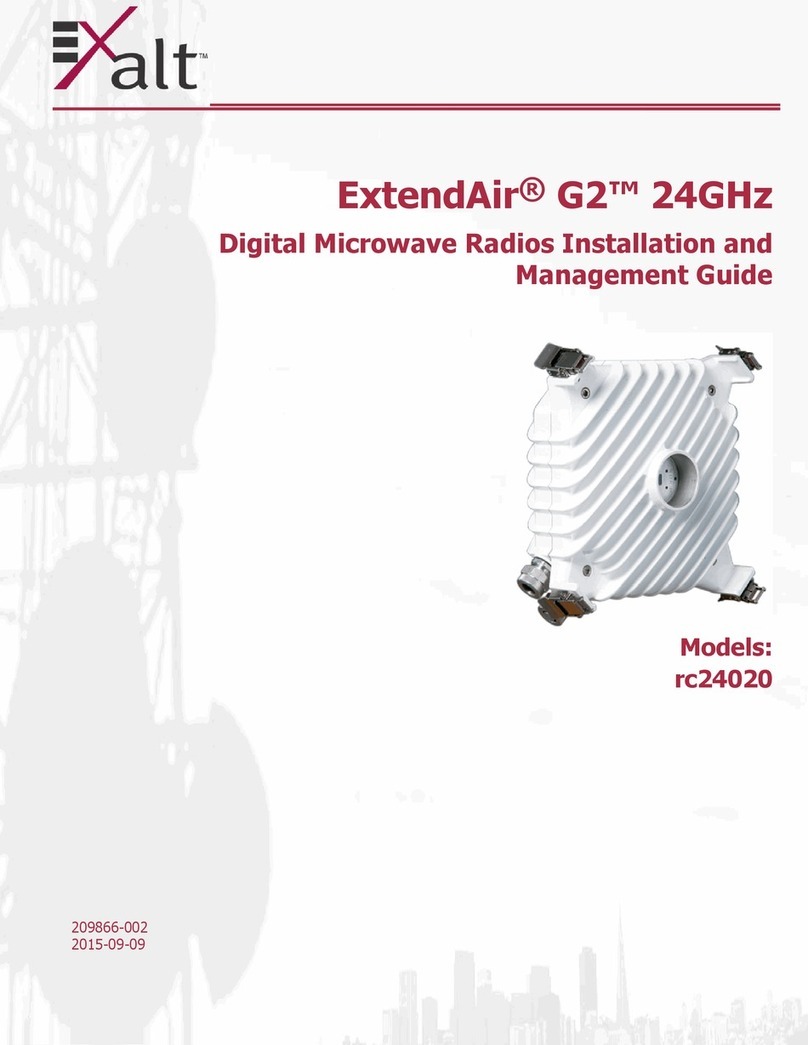
Exalt
Exalt ExtendAir G2 Programming manual
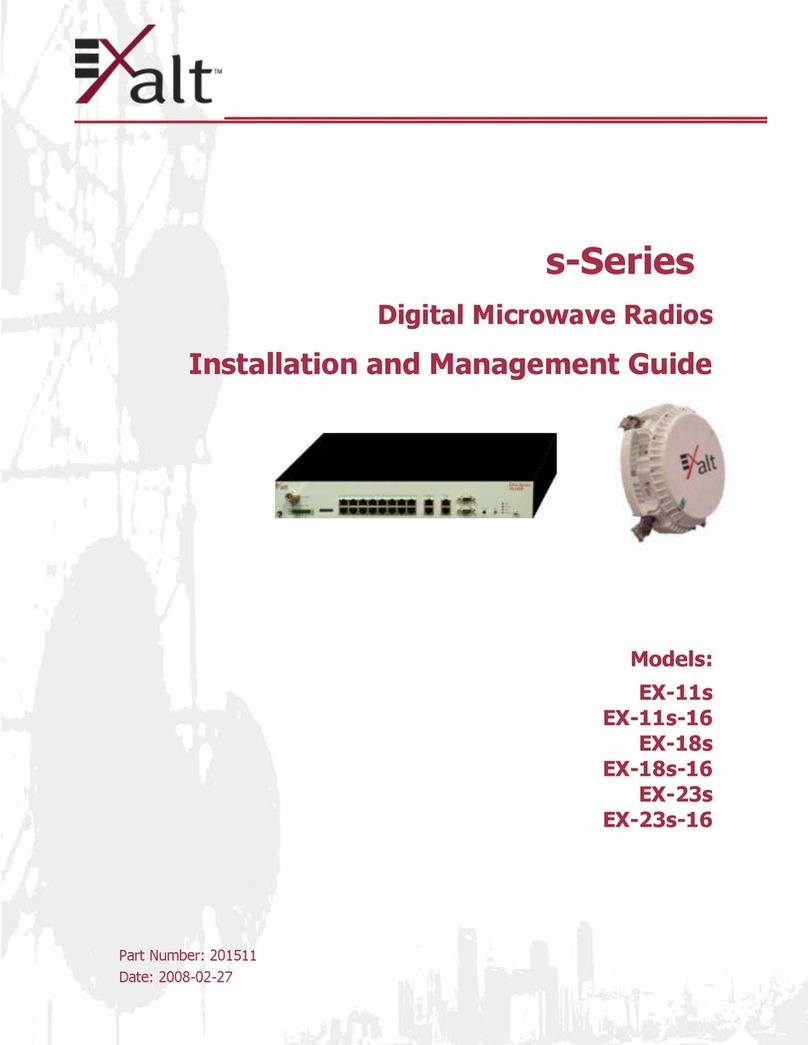
Exalt
Exalt S Series Programming manual
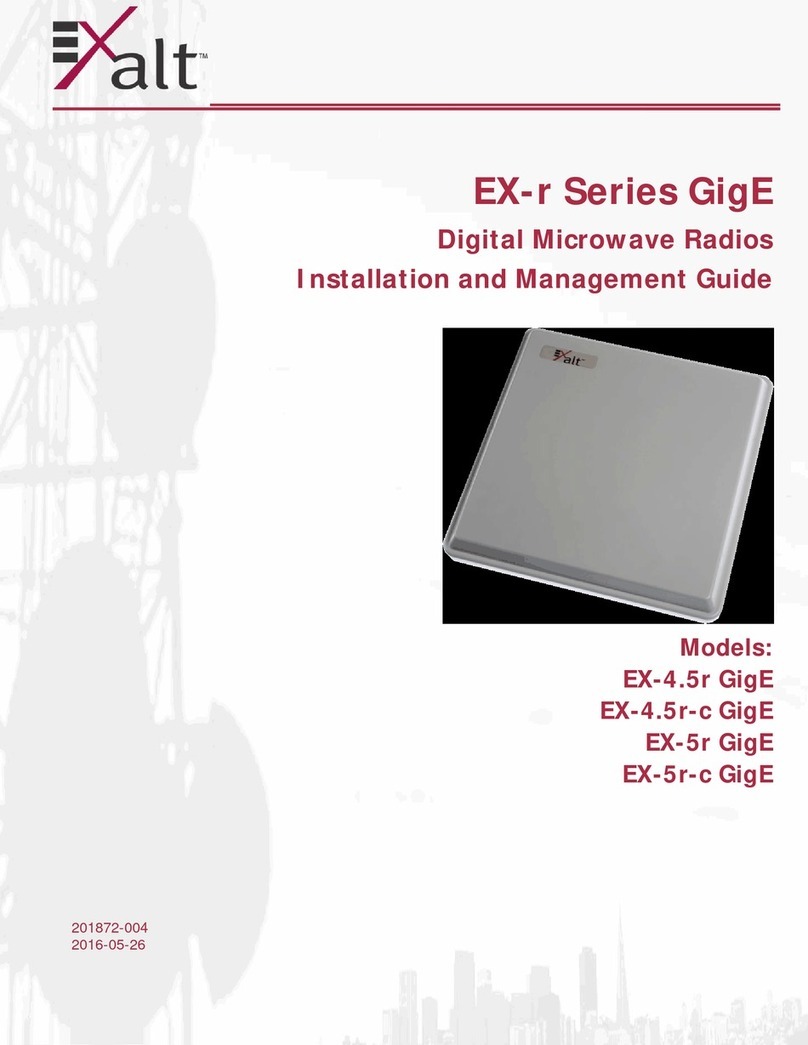
Exalt
Exalt EX-4.5r GigE Programming manual
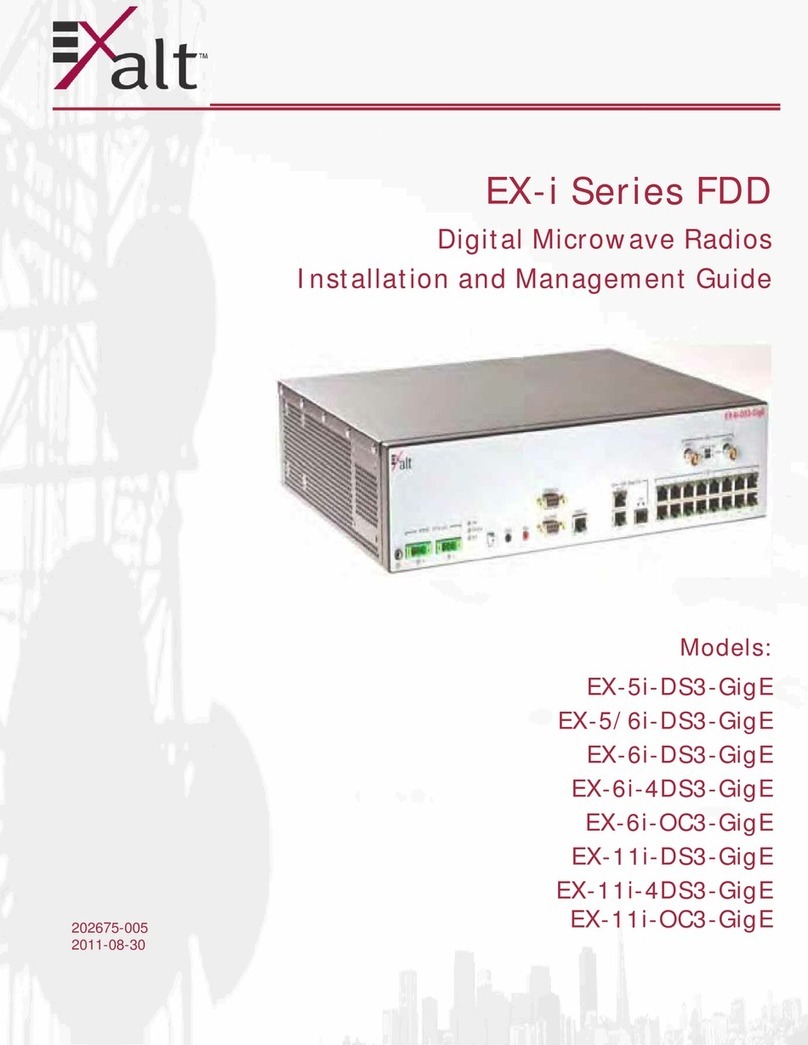
Exalt
Exalt EX-5i-DS3-GigE Programming manual
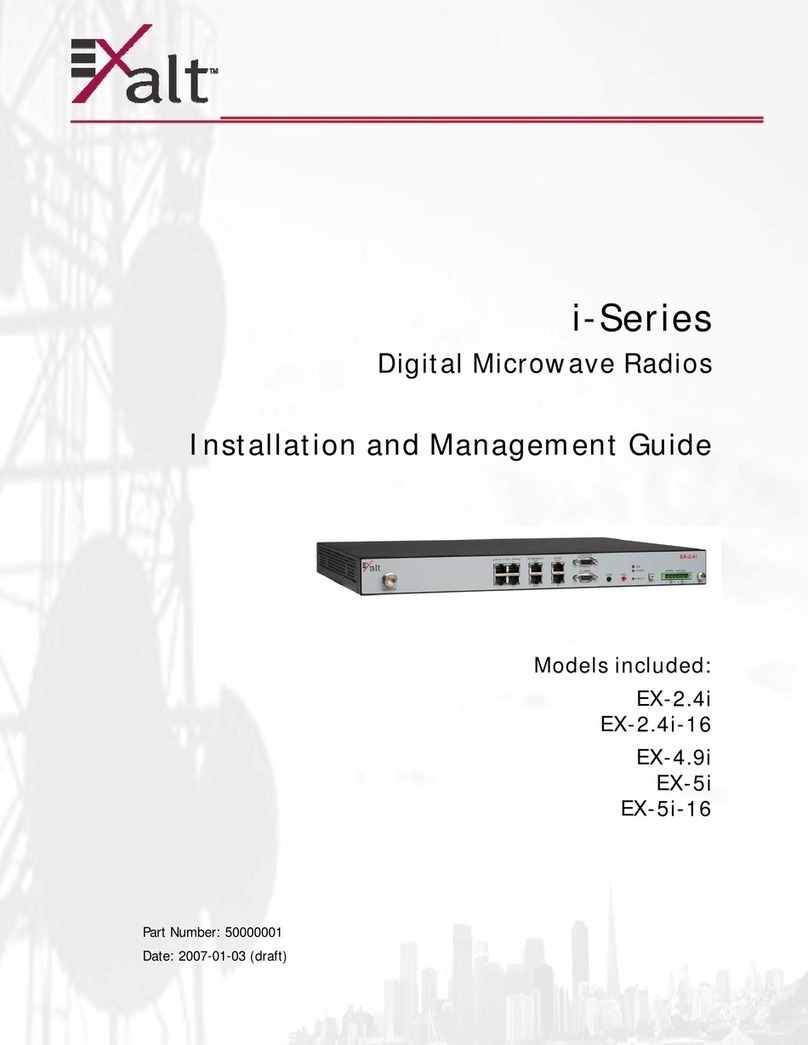
Exalt
Exalt EX-2.4i Lite Programming manual

Exalt
Exalt ExtendAir series User manual
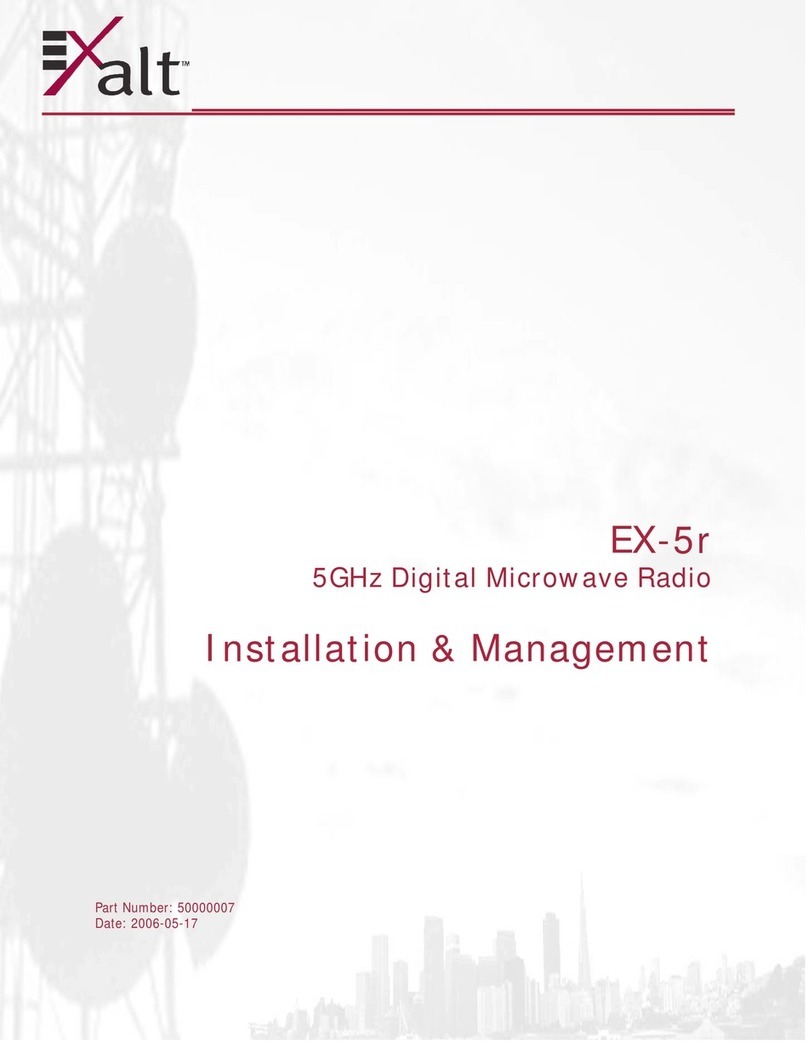
Exalt
Exalt EX-5r GigE Instruction Manual
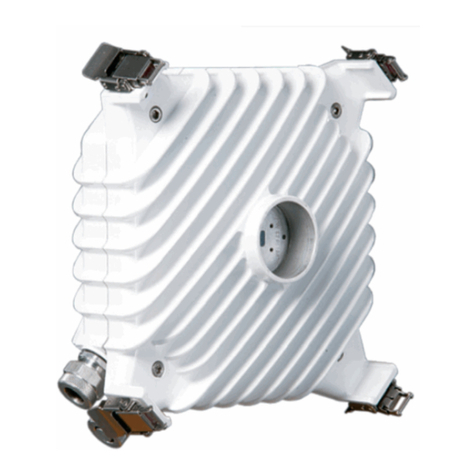
Exalt
Exalt rc06020 FCC Programming manual
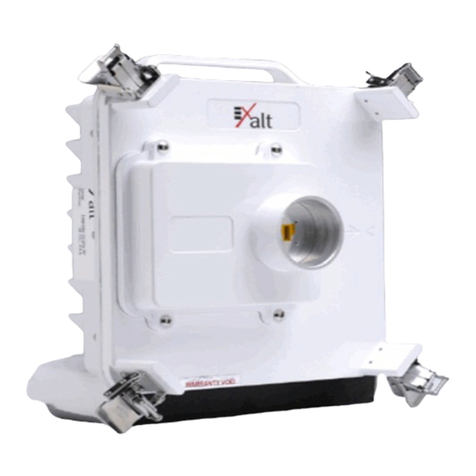
Exalt
Exalt ExtendAir series Programming manual

Exalt
Exalt r5050 Series Programming manual

